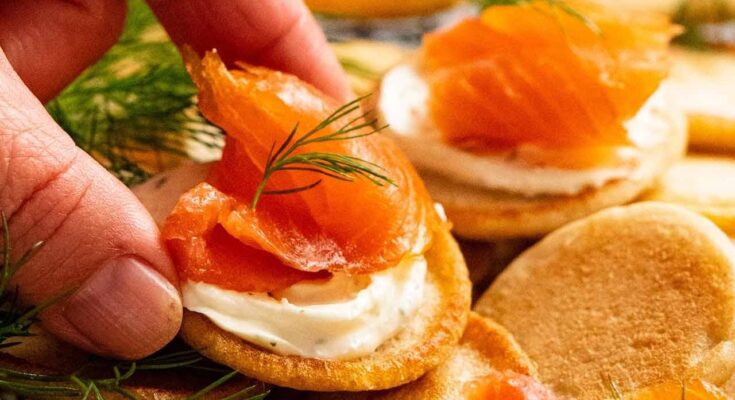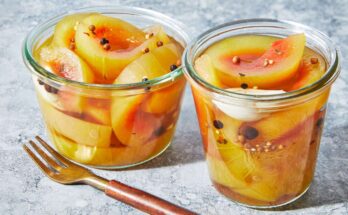Blini Recipe: Blini are thin, crepe-like pancakes that originate from Russia and Eastern Europe. Think of them as the Slavic cousin to the French crêpe, but with a flavor and texture that’s uniquely rich and satisfying. Traditionally made with wheat or buckwheat flour, blini are light, airy, and soft, making them perfect for a variety of toppings—both sweet and savory.
What sets blini apart is their versatility. They can be served for breakfast, lunch, dinner, or even as a dessert. Whether you’re hosting a brunch or planning a festive dinner party, blini can easily steal the show. The dough is made using simple ingredients like flour, milk, eggs, and yeast or baking soda, and they can be cooked quickly on a skillet or griddle.
So why are blini so beloved across cultures? Because they’re not just delicious—they’re also customizable, comforting, and surprisingly easy to make from scratch.
History and Cultural Significance
Blini aren’t just food—they’re a symbol of culture, heritage, and even spirituality in Russia. Dating back over a thousand years, these golden pancakes have deep roots in Slavic traditions. In pre-Christian times, they were baked to honor the sun during Maslenitsa, a Russian festival marking the end of winter and the beginning of spring.
Their round, golden appearance symbolized the sun, and eating them was believed to bring warmth and light into one’s life. After the advent of Christianity, blini maintained their place in Russian culture, becoming a staple dish during Lent and other religious observances.
Today, blini are celebrated across generations. Grandmothers pass down their special recipes, while modern chefs infuse creativity into classic versions. They’re served at weddings, holidays, and family reunions—offering a taste of tradition in every bite.
Ingredients You’ll Need
Basic Ingredients for Traditional Blini
Before diving into the cooking process, let’s get our pantry in order. Here’s a list of the core ingredients required to make authentic, fluffy blini:
- All-purpose flour – 1 ½ cups
- Milk (warm) – 2 cups (whole milk preferred for richness)
- Eggs – 2 large
- Butter (melted) – 2 tablespoons
- Sugar – 1 tablespoon
- Salt – ½ teaspoon
- Dry yeast or baking soda – 1 teaspoon (choose yeast for a lighter, airier result)
These ingredients form the foundation of the batter. It’s important to use fresh, high-quality components to ensure your blini taste just right. You can also swap wheat flour with buckwheat if you’re aiming for a more traditional Eastern European flavor profile.
One tip here—sift the flour before mixing. This small step helps remove clumps and ensures the batter stays smooth and lump-free. And make sure your milk is warm, not hot. Too much heat can kill the yeast, and nobody wants a flat pancake!
Optional Add-ins and Toppings
Now comes the fun part—customization. Blini are like blank canvases, waiting for your personal touch. You can tweak the batter or pile on toppings based on your mood or occasion.
Optional batter add-ins:
- A splash of vanilla extract for a sweet version
- A pinch of cinnamon or nutmeg
- A bit of sour cream or yogurt for extra tang
Popular sweet toppings:
- Honey and nuts
- Jam or preserves (strawberry, raspberry, apricot)
- Fresh berries and whipped cream
- Sweetened condensed milk
- Nutella or chocolate spread
Savory favorites:
- Smoked salmon and cream cheese
- Caviar and crème fraîche (classic Russian combo)
- Sautéed mushrooms and sour cream
- Shredded chicken or ham with cheese
You can also roll or fold blini into wraps, crepes, or bite-sized appetizers. The possibilities are endless!
Preparing the Blini Batter
Step-by-Step Mixing Process
Let’s get hands-on! Making the batter is the first step toward mouthwatering blini. Here’s how to do it right:
- Activate the yeast (if using): In a small bowl, mix the yeast with a teaspoon of sugar and a few tablespoons of warm milk. Let it sit for 5-10 minutes until it foams. This shows that your yeast is alive and active.
- Combine the wet ingredients: In a large mixing bowl, whisk together the remaining warm milk, eggs, and melted butter.
- Add the dry ingredients: Slowly sift in the flour, sugar, and salt while continuously whisking to prevent lumps.
- Mix it all up: Once the flour is fully incorporated, stir in the activated yeast mixture. Keep mixing until you get a smooth, lump-free batter. The consistency should be similar to heavy cream.
- Let it rest: Cover the bowl with a towel or plastic wrap and let the batter rest for 30–60 minutes in a warm place. This allows the yeast to work its magic, making your blini light and airy.
Resting time is critical. It not only improves texture but also deepens the flavor, especially if you let the batter sit longer. Don’t rush this step—good things take time.
Tips for the Perfect Consistency
Getting the batter just right can be a game-changer. Here’s how to ensure your blini come out light, fluffy, and golden every single time:
- Don’t overmix: Stir just enough to combine ingredients. Overmixing can lead to tough, rubbery pancakes.
- Check thickness: If your batter is too thick, add a splash of warm milk. Too runny? Add a tablespoon of flour at a time.
- Use room temperature ingredients: This helps create a uniform batter and encourages even cooking.
- Rest your batter: As mentioned, rest time helps activate the yeast and breaks down gluten, leading to softer blini.
Your batter is now ready! Time to heat the pan and start flipping!
Cooking the Blini
Heating the Pan Correctly
Before you pour that first scoop of batter, your pan must be properly prepped. A good blini starts with the right heat—too hot and you’ll burn them; too cool and they’ll be rubbery and undercooked. Here’s how to nail it:
Start with a non-stick skillet or a seasoned cast-iron pan. These are perfect for evenly cooking blini and preventing them from sticking. Place the pan over medium heat for 2–3 minutes until it’s hot but not smoking.
To test the heat, sprinkle a few drops of water onto the surface. If they sizzle and evaporate quickly, you’re ready to go. Lightly grease the pan with a dab of butter or a brush of oil before every couple of blini to keep things smooth and crispy without overloading on fat.
Temperature control is key. Keep the heat steady and adjust as needed. Too high, and your blini will brown too fast on the outside while staying raw inside. Too low, and they’ll take forever and turn rubbery.
Having a consistent heat also helps in maintaining the same texture and color across all blini—no one wants a stack of mismatched pancakes!
Pouring and Flipping Techniques
Now the magic begins. Pouring and flipping blini takes a little practice but once you get the hang of it, it becomes second nature.
- Use a ladle or measuring cup to pour the batter. About 1/4 cup is perfect for each blin. Pour into the center of the hot pan, then quickly tilt the pan in a circular motion to spread the batter evenly across the surface.
- Cook for 1–2 minutes on the first side. You’ll know it’s ready to flip when the edges look dry and little bubbles form on top.
- Flip gently using a thin spatula. Slide it underneath, lift it slightly, and flip in one smooth motion. Don’t worry if the first one isn’t perfect—think of it as a tester.
- Cook for another 30 seconds to 1 minute on the other side. The goal is a light golden-brown color with a soft, tender center.
- Transfer to a plate and cover with a clean towel to keep warm while you finish the rest.
Repeat until all your batter is gone. You should end up with 12–15 beautiful, round blini ready to serve.
If you’re feeling adventurous, try stuffing your blini before folding—think cheese, meat, or jam. Just spoon your filling onto one half of the blin, fold it over like a taco, and cook for another minute until the filling is warm and gooey.
Serving Suggestions
Sweet vs. Savory Toppings
Blini are like little edible canvases—you can paint them with sweet or savory flavors depending on your mood or the occasion. Let’s explore both worlds:
Sweet Toppings:
- Jam and Preserves: Classic choices like strawberry, raspberry, or apricot add a fruity punch.
- Fresh Berries and Cream: A combo of whipped cream and seasonal berries is as elegant as it is delicious.
- Nutella and Bananas: A decadent dessert version loved by both kids and adults.
- Honey and Nuts: Drizzle honey and sprinkle crushed walnuts or almonds for a nutty crunch.
- Powdered Sugar: A simple dusting makes for a classy finish.
Savory Toppings:
- Caviar and Crème Fraîche: The ultimate Russian delicacy. Fancy, flavorful, and rich.
- Smoked Salmon and Dill Cream Cheese: Elegant and satisfying, especially for brunch.
- Sautéed Mushrooms and Onions: Earthy and comforting, great as a main dish.
- Ham and Cheese: A simple yet hearty option.
- Sour Cream and Herbs: Keeps it traditional and flavorful.
You can also serve blini stacked like a cake, rolled with fillings inside, or folded into quarters. Presentation adds flair, especially when entertaining guests.
Best Pairings for Blini
Blini pair beautifully with a range of sides and drinks, making them the highlight of any meal. Here’s what you can serve alongside:
Drinks:
- Hot tea: Classic pairing in Russian culture.
- Champagne or sparkling wine: Perfect for a caviar-topped blini.
- Coffee or espresso: Great for sweet varieties.
- Vodka: A traditional Russian touch for festive occasions.
Side Dishes:
- Light salad with vinaigrette: Balances the richness of blini.
- Pickled vegetables: Adds tang and texture, especially with savory toppings.
- Fruit salad or compote: Complements sweet blini.
Blini are more than just pancakes—they’re an experience. The joy is in the variety and the opportunity to mix and match flavors to suit your cravings.
Blini for Special Occasions
Blini During Maslenitsa Festival
Maslenitsa, also known as Pancake Week, is a traditional Russian holiday that marks the end of winter and the beginning of spring. And guess what steals the show during this celebration? You got it—blini. These golden, sun-shaped pancakes represent warmth, sunshine, and the joy of the changing season.
The festival lasts an entire week, and each day has its own customs, from visiting family to community feasts. Blini are served throughout the week in many forms—stuffed, stacked, topped, and rolled. They’re shared with friends and strangers alike, symbolizing goodwill and hospitality.
During Maslenitsa, blini aren’t just food; they’re a symbol of renewal and connection. It’s common to see people gathered around tables piled high with blini, each bite echoing centuries of tradition. If you’re planning a cultural event or themed dinner, serving blini is a beautiful way to honor this festive heritage.
Want to go the extra mile? Decorate your table with sunflowers, wear bright colors, and serve traditional accompaniments like sour cream, jam, and caviar. You’ll be bringing the spirit of Maslenitsa to life in your own kitchen.
Blini at Weddings and Celebrations
Blini aren’t just reserved for festivals—they’re a staple at weddings, birthdays, christenings, and even funerals in Russian and Eastern European cultures. Their symbolism of warmth, continuity, and shared heritage makes them a meaningful addition to any celebration.
At weddings, blini are often part of the pre-ceremony meals, served to guests as a welcoming gesture. Filled with rich toppings or wrapped around meats and cheeses, they signify prosperity and happiness for the newlyweds.
In modern times, blini are also featured at high-end events and gourmet brunches. You’ll see them in elegant presentations, rolled with smoked salmon and dill, or topped with exotic jams and artisanal cheeses.
They’re also an amazing option for buffets and platters, thanks to their compact size and versatility. Whether you’re hosting a casual brunch or an upscale dinner party, you can’t go wrong with a creative blini spread.
Making Blini Gluten-Free or Vegan
Alternative Flours and Dairy-Free Options
No one should have to miss out on the joy of eating blini—dietary restrictions or not! With just a few tweaks, you can make gluten-free or vegan versions that are just as delicious as the originals.
For gluten-free blini:
- Use buckwheat flour (naturally gluten-free and traditional in Russian recipes).
- Substitute with gluten-free all-purpose flour or a mix of rice flour and tapioca starch.
- Add xanthan gum if needed for better structure.
For dairy-free blini:
- Replace milk with almond milk, oat milk, or soy milk.
- Use vegan butter or coconut oil instead of dairy butter.
For egg-free blini:
- Use a flaxseed egg (1 tablespoon ground flaxseed + 3 tablespoons water, let sit for 5 mins).
- Or try a mashed banana or applesauce as a binding agent in sweet versions.
The key is balancing the ingredients to maintain the right texture—thin, soft, and easy to flip. Gluten-free batters may need a bit more resting time, while vegan batters may require more moisture.
Whether you’re gluten-intolerant, lactose-sensitive, or fully plant-based, there’s a way to make blini work for you. Try a few variations to see which ones you love the most!
Storing and Reheating Blini
How to Store and Freeze Blini
Made too many blini? Don’t worry—they store and freeze beautifully. Here’s how to keep them fresh:
For short-term storage:
- Let the blini cool completely.
- Stack them with parchment paper between each one to prevent sticking.
- Store in an airtight container or zip-top bag in the fridge for up to 3–4 days.
To freeze:
- Follow the same method as above—cool, stack, separate with parchment.
- Place in a freezer-safe bag or container.
- They’ll keep well for up to 2 months.
When you’re ready to eat, simply reheat in a pan over medium heat for a minute or two on each side. You can also microwave them with a damp paper towel or warm them in the oven at 300°F (150°C) for 10 minutes.
Avoid reheating too many times, as they can dry out. For the best texture, add a small dab of butter while reheating to bring back that fresh-off-the-pan flavor.
Common Mistakes and How to Avoid Them
Troubleshooting Blini Recipes
Even seasoned cooks can run into a few blini blunders. Let’s look at the most common mistakes and how to fix them:
Batter too thick or lumpy?
- Thin it with warm milk.
- Always sift your flour and mix gently to avoid lumps.
Blini tearing when flipping?
- Let them cook fully on one side before flipping.
- Use a non-stick pan and a thin spatula.
Too pale or too dark?
- Adjust the heat! Medium heat is the sweet spot.
- Wipe the pan lightly between batches to prevent burning.
Rubbery texture?
- Overmixing can be the culprit.
- Let the batter rest for at least 30 minutes.
Flat and dense?
- Check your yeast or baking soda—make sure they’re fresh.
- Allow enough resting time for air bubbles to form.
Perfection comes with practice. Don’t get discouraged if your first few don’t come out right. You’ll be flipping flawless blini in no time.
FAQs about Blini Recipe
What are blini?
Blini are thin, Russian-style pancakes made from wheat or buckwheat flour. They’re often served with sweet or savory toppings like sour cream, caviar, jam, or smoked salmon.
Are blini and crepes the same?
Not exactly. While similar in appearance, blini are traditionally thicker than French crepes and can be made with yeast or baking powder, giving them a fluffier texture.
Can I make blini ahead of time?
Yes! Blini can be made in advance and stored in the fridge for up to 2 days. Just reheat them in a skillet or microwave before serving.
Can blini be frozen?
Absolutely. Stack them with parchment paper in between, wrap tightly, and freeze for up to 2 months. Thaw and reheat as needed.
What toppings go best with blini?
Blini are versatile. For savory options, try sour cream with caviar, smoked salmon, or sautéed mushrooms. For sweet toppings, use honey, jam, or Nutella.
Are blini gluten-free?
Traditional blini are not gluten-free. However, you can make a gluten-free version using buckwheat flour or a gluten-free flour blend.
Do I need yeast for blini?
It depends on the recipe. Some traditional Russian blini recipes use yeast for a light, airy texture, while others rely on baking powder for a quicker version.
Conclusion
Blini are so much more than just pancakes—they’re a bridge between tradition and creativity, a comfort food with cultural roots, and a blank canvas for flavors both sweet and savory. Whether you’re honoring Russian heritage, preparing a cozy family breakfast, or impressing guests at brunch, blini deliver every single time.
With this step-by-step guide, you’ve got all the tools you need to master the art of making blini. From mixing the perfect batter to flipping like a pro, serving them sweet or savory, and even going gluten-free or vegan—there’s a version for everyone.
So grab your skillet, whisk that batter, and start your journey into the warm, delicious world of blini.



